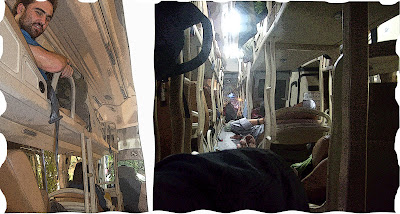
I'm a huge fan of Christmas and love the build up – decorations, advent calendars, Christmas films (even the nonsense the Christmas Channel shows!)... The only thing I'm not a fan of is traditional Christmas food and this year finally made the much talked about alternative all-meat decorative mince pies. Of course supposedly being an adult and knowing the “Christmas secret” means Christmas morning isn't as exciting as it used to be but I still love my family's annual routine – stocking opening for all (regardless of age), church, lunch, the Queen's speech, presents and games.
This year with so many members of my family ill, for the first time ever the pressure to go to church was off and church goers seriously diminished but because it's part of a long-held tradition, I braved the service voluntarily. One year The Boy threatened to abstain and found himself locked outside and shoeless with little choice but to join the rest of the family but this year no such shenanigans occurred. These days when it comes to presents, I still love opening them and sure, I still experience the same spoilt mix of glee and disappointment but I'm generally more excited to see the reactions of those I've bought presents for.
In many ways I enjoy Boxing Day more than Christmas Day as we embark on another strange family tradition – a dress up themed evening. This year there's a Spanish theme. Bumbling around as one of Dali's melting clocks, I think back to a clueless conversation I had in Cologne about the origins of the name “Boxing Day” and Germany's much simpler title: “Second Christmas Day”. I remember having to do various Christmas projects at school and rather obviously vaguely recall the name having something to do with presents.
Celebrated in Australia, Canada (an optional holiday, except for Ontario where it's statutory), New Zealand and other commonwealth nations, Boxing Day is also known as “Day of Goodwill” (South Africa) and “St Stephen's Day”/”The Day of Wren” (Ireland). Originally established through the 1871 Bank Holidays Act during Queen Victoria's reign, although dating back to medieval times, the exact etymology of the name “Boxing Day” is unclear. There are several linked and competing theories all sounding just as plausible:
The tradition of giving money and other gifts to those who were needy on the day after Christmas. Gifts were placed into boxes for easier transportation.
The European tradition dating back to the Middle Ages and possibly even the late Roman/early Christian era of placing metal boxes outside churches that were used to collect special offerings tied to the Feast of Saint Stephen. St. Stephen was one of the seven original deacons of the Christian Church who were ordained by the Apostles to care for widows and the poor. As told in the Acts of the Apostles 6:1 to 8:2 , in exchange for his dedicated preaching and devotion to Christ, St. Stephen was stoned to death by a mob and as he died begged God not to punish his killers. Some folk believe that there's a Swedish St Stephen, who is the patron saint of horses and thereby associates Boxing Day with outdoor sports, especially horse racing and hunting.
The 19th Century Victorian custom that saw servants in Britain carry boxes to their masters when they arrived for the day's work. On the day after Christmas, it was tradition that all employers would put coins in the boxes, as a special end-of-the-year gift. Some records show these boxes were earthenware and would be collected to be smashed open on Boxing Day. Linked to this tradition is the idea that on Boxing Day tradesmen would collect their "Christmas boxes" or gifts in return for good and reliable service throughout the year – rather like the modern concept of a “Christmas Bonus”. Equally in America where Boxing Day isn't celebrated, slaves were given goods from masters to show their appreciation and sometimes allowed a few days off to spend with their family.
The old English tradition that allowed servants to take the 26th December off to visit families in exchange for ensuring that wealthy landowners' Christmases ran smoothly. In addition, employers gave each servant a box containing gifts and bonuses (sometimes including leftover food). The goods were distributed based on the family's needs, the status of the worker and their services to the giver, with spun cloth, leather goods, durable food supplies, tools, and other items being handed out. The items were chucked into boxes, one box for each family, to make carrying away the results of this annual restocking easier.
The tradition prevalent in the 1800s of churches opening their alms boxes (boxes where people place monetary donations) to distribute the contents to the poor.
Whichever explanation you decide to go with what's important to remember is Boxing Day was traditionally a day to thank the community for the year's efforts and while being a gracious day, also reinforced class lines as social superiors did not receive gifts from those deemed to be of inferior social standing.

















